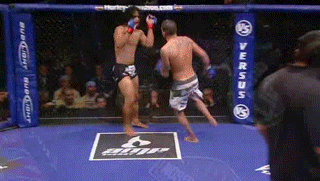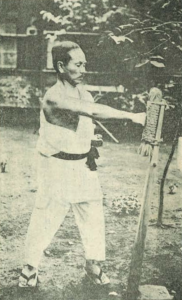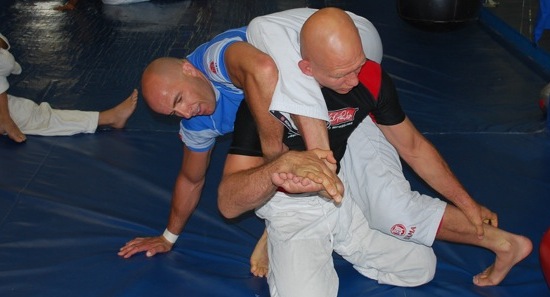If you’ve spent any time in the world of martial arts then you know there can be a dizzying variety of disciplines to train in.
And within each of those martial arts styles there are further differences depending on which school or instructor you train with.
But there’s an easy way to simplify all these different martial arts and styles and it comes down to something the legendary Dan Inosanto once told me…
He said that every martial art consists of three different components: the techniques, the equipment, and the training methods.
Here’s the video that got me thinking about this topic; it has a ton of examples of these 3 components (and about a million wardrobe changes), but I then wrote an article which further elaborates on this topic. Watch the video and/or scroll down to read the article below…
Looking at any given martial art through these lenses is actually very useful, because it allows you to beg, borrow and steal the best aspects of each martial art and add it to your own way of training.
Let’s take a look at each of these three critical components in order…
MARTIAL ART COMPONENT 1: TECHNIQUES
Techniques are the movements and postures specific to your discipline.
A few examples of martial arts and some of their signature techniques include:
- Boxing: jab, cross, hook, uppercut, bob and weave, etc.
- Freestyle wrestling: double leg takedown, single leg takedown, inside trip, cradle, suplex, Turk, etc.
- Fencing: lunge, parries, riposte, disengage, flèche, etc.
- MMA: right cross, double leg takedown, superman punch etc.
- Muay Thai: round kick, teep, clinch knee, spinning elbow, etc.
- Judo: Osoto gari, uchi mata, o goshi, juji-gatame, sangaku-jime, etc.
- Kung fu: the “shadowless kick,” “monkey steals the peaches” and 1000 other fancifully named techniques!
Clearly the actual techniques used differ enormously between arts…
Harimau Silat and Chinese Baquazhang look nothing alike. Filipino Kali is very weapons-centric, whereas western boxing is entirely an empty-handed system. Kyokoshin karate, Capoeira and Judo are easily recognisable as totally different systems, even by laypeople with no martial arts experience.
In the modern era it’s not uncommon for cross-pollination to occur between different systems. This has been going on forever, but with the advent of online video it’s going faster than ever…

Anthony Pettis landed his famous running-jumping-cage kick on December 16, 2010. Thanks to the internet I’m sure that tons of fighters were training the same technique in their gyms the very next day.
(It’s hard to emphasise how revolutionary it is for information to spread this fast. If you were a samurai in 16th century Japan, and you used a secret sword fighting technique to win a duel, then it wasn’t as if all the other samurai in the country had the opportunity to check out your cool new move and do the frame-by-frame analysis on Youtube.)
This democratisation of technique is something new. You’re free to borrow new moves as you see fit, but at the same time keep in mind that if you develop something really cool then everyone is watching you too!
Obviously techniques are the easiest thing to copy, but they are NOT the only thing that defines a martial art. The next two aspects are just as important, but a little bit more subtle, less appreciated but just as important.
The equipment used in training, and the training methods themselves, have a HUGE effect on the final martial arts product!
MARTIAL ARTS COMPONENT 2: EQUIPMENT
Traditionally many martial arts had their own unique training devices and equipment.
Some examples of martial arts equipment might include:
 Wrestling: wrestling mat, crash mat, takedown and suplex dummies
Wrestling: wrestling mat, crash mat, takedown and suplex dummies- Karate: makiwara (punching board), chi-ishi (macebell), ishi-sashi (stone padlocks), nigiri game (gripping jars)
- Boxing: gloves, headgear, heavy bag, speed bag, uppercut bag, focus mitts
- Sumo: doyho (the ring), mawashi (the sumo loincloth), teppo pole (slapping pole)
- Wing Chun Kung Fu: wooden dummy, rattan and steel forearm rings, wall mounted punching pads
- Thai boxing: thai pads, long thai bag, uppercut bag, focus mitts, shin roller, banana tree trunks (traditionally)
The presence or absence of specific training equipment can have a HUGE effect on a martial art.
For example, consider how the boxing glove has changed boxing technique.
In the old days of bare knuckle boxing there were far fewer head shots.
Typically boxers back in the day would hold their hands lower and focus on power shots to the body. The risk of breaking your hand striking the wrong part of the head was a deterrent.
Now, because gloves are widely used in training, the hands are usually held higher, and head shots are much more common (this is true even in modern ‘bare knuckle boxing’ in the British Isles where combatants usually still use extensive hand wrapping even if they don’t use gloves).
Another great example is how the practise of Brazilian Jiu-jitsu is changed by the presence and availability of training mats.
The use of mats for everyday training allows people to spend a lot more time on the bottom developing their skills than they might if they were training on concrete.
Although scrapes and bruises wouldn’t worry me in a real street confrontation, if I ended up mauled and unable to walk every time I grappled then I’d certainly be much less inclined to train positions like the guard or my escapes from bad positions.
The mats in jiu-jitsu allow you to avoid getting too badly beaten up in training, which then encourages you to put in more time on the mat and get in more repetitions for skill development.

MARTIAL ARTS COMPONENT 3: TRAINING METHODS
Training methods are the systems, drills and exercises used by a martial art in order to drill the techniques and make them instinctive.
Essentially this is where you learn how to make your techniques smooth, instinctive, and functional in a real-life situation!

Every system has one or more training methods that shape the entire expression of entire art.
Karate has its katas and one-step sparring…
Wing chun has its 3 primary forms, sticky hands, and the wooden dummy…
Boxing has its shadowboxing, heavy bag training, focus mitt training, and sparring…
Judo has two person uchikomi, three person uchikomi, tachiwaza randori, newaza randori, and yes, kata…
Back when I trained in Hung Gar and Northern Shaolin Kung Fu as a teenager, after a warmup we then spent 20-30% of our training time working our stances and basic punches, kicks and blocks.
Then we spent the majority of our time (at least 50%) working on forms (kata). We would repeat the same sequence of moves again and again and again with the hope that in a real fight the moves would suddenly pop into our heads and we would magically execute them on someone.
Then we spent the remaining time hitting punching bags, and doing two-person forms.
So in the case of the Kung Fu I was training we used four primary training methods:
- Isolated technique repetition (punches and kicks from a static stance)
- Single person forms/kata
- Two person forms/kata
- Punching bag training
In retrospect I don’t think that these training methods were a particularly effective or efficient way to use our time for combative effectiveness.
Even if we were using ‘traditional’ kung fu techniques we should have been using at least some modern training methods.
Just because you’re training in one martial art means that you need to limit yourself to the training methods of that art. Maybe somebody else, somewhere in the world, has thought of a better way to train a certain type of technique, and if it works then you should use it!
For example, in modern mixed martial arts fighters will usually go to separate wrestling, kickboxing and jiu-jitsu classes.
In each of those classes they may be using training methods unique to that style; in jiu-jitsu they may be shrimping and bridging, doing drills of repeated swinging armbars, and sparring, whereas on a given day in boxing they may mostly be working their shadowboxing and hitting the focus mitts.
And then they’ll put it all together in blended MMA practices, which brings us to…
THE MOST IMPORTANT TRAINING METHOD OF ALL
If the UFC and the clash of systems in modern MMA have taught us anything it’s that pressure testing through sparring is the secret sauce of what makes a martial art really work.
In fact, even if the reason you train is 100% street oriented then you’re still way better off spending most of your time training and sparring with less deadly techniques (that you can actually apply against full resistance) rather than focusing only on the eye gouges and carotid artery bites which, although undeniably deadly, are almost impossible to train against full resistance.
So the armbar and the triangle choke beat the nose bite and the groin tear almost every time.
(Besides, can you imagine what would happen if a high level MMA fighter, with all his crazy speed and accuracy, decided to fight dirty all of a sudden? The hard part is developing your timing and accuracy; once you have that then adding a ‘dirty’ technique like an eye gouge to your repertoire would be child’s play)
“You can borrow techniques, training methods, or even pieces of training equipment from other martial arts.” https://t.co/AM9UHYee8q
— SelfDefenseTutorials (@SelfDefenseTut) March 20, 2017
In many cases sparring is a critical part of the training method. There is nothing that beats sparring for a true pressure test of your training and fighting ability. You’ll find out very quickly where the holes in your technique are when you find a fist flying through your defenses!
By sparring I mean that you are really trying to submit or hit your opponent, and he or she is really trying to attack you. Not every training session needs to involve full on battle-to-the-death sparring, maybe on certain days you’ll spar with the jab only, but the bottom line is that you’ll really be trying to stick the jab in your opponent’s face and he’ll really be trying to do it to you as well.
Training your techniques under pressure against someone who really doesn’t want to let you do them to him should be a regular part of your routine if you want your training to be street ready.
Without battle testing your techniques, you run the risk of getting far too theoretical.
Imagine a champion boxer who teaches his protege all the moves he knows. They practice weaving, footwork, and striking patterns — but the student never actually fights anyone. Now this student goes and teaches another generation of students all the moves he learned. He may put them into sequences (kata) and give them names for ease of remembering. His students learn various sequences of movements strung together…but none of them ever meet a target that strikes back.
Within just a few generations you’d go from an incredibly effective martial art to one that consists mostly of imaginary prancing about, defeating legions of attackers with techniques that you’re sure are ‘too deadly to spar’.
If this is beginning to sound familiar, that’s because it is. There are many ancient martial arts that began as practical systems for combat, but through generations of being passed down without contact sparring, they have lost touch with their original purpose. Too much tradition and too little testing!
THE BOTTOM LINE…
Your training should be an ongoing process of gaining new skills, weaving them into what you already know, and – very importantly – testing them against resistance at least occasionally.
In the modern era you can borrow techniques, training methods, or even pieces of training equipment from other martial arts systems and use them in your own practice.
It’s a great time to be a martial artist – good luck with your training!
P.S. If you want to receive our self defense tips by email please enter your email address in the box below. You’ll get some of our best tips, techniques and tactics by email, and if you don’t like it you can easily unsubscribe with a single click at any time.
Get My FREE Self Defense Tips by Email